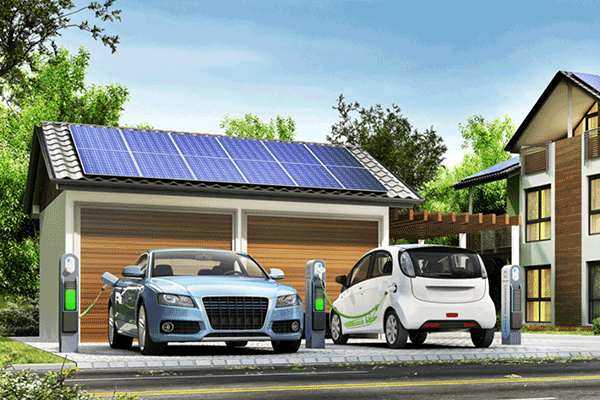As electric vehicles gain traction and renewable energy rises in prominence, an increasing number of drivers are contemplating the shift to solar power for charging their vehicles. Solar energy is not just a clean power source; it represents a self-sufficient lifestyle. This article will delve into a crucial question: How many solar panels do you need to charge your EV at home?

Understanding EV Electricity Requirements
To determine the number of solar panels needed to charge an electric vehicle, we must first understand the EV’s electricity requirements. The power consumption of an EV is typically measured in kilowatt-hours per 100 miles (kWh/100 mi). Additionally, we must consider the total electricity needed to fully charge the vehicle, akin to how we think about the cost to fill up a tank of gas in traditional combustion engine cars.
Here is a table with the battery capacity, range, and kWh per 100 miles for some popular electric vehicle models, which are key to calculating the number of solar panels needed:
| Brand | Model | Battery Capacity (kWh) | Range (miles) | Energy Consumption (kWh/100 mi) |
|---|---|---|---|---|
| Tesla | Model S | 100 | 370 | 27 |
| Audi | e-tron | 95 | 204 | 46 |
| Hyundai | Kona | 64 | 258 | 24.8 |
| Kia | Soul EV | 64 | 243 | 26.3 |
| Chevrolet | Bolt EV | 60 | 238 | 25.3 |
| BMW | i3 | 42 | 153 | 27.5 |
| Nissan | LEAF | 40 | 150 | 26.7 |
| Volkswagen | e-Golf | 36 | 125 | 28.9 |
| Honda | Clarity | 26 | 89 | 29.2 |
Solar Panels and EV Charging
The relationship between solar panels and EV charging is central to this discussion. The output power of a solar panel, measured in watts, directly affects the time it takes to charge an EV. The efficiency of solar panels varies by geographic location, meaning the amount of electricity they produce can differ from one region to another.
Solar panel efficiency typically ranges from 15% to 20%, indicating that not all of the solar energy received can be converted into electrical energy. For example, a 300-watt solar panel under ideal conditions can generate 300 watts of power per hour, but in reality, due to various factors such as weather conditions and installation angles, its actual output may be less.
To charge an EV, we need to calculate the average daily electricity production of solar panels in a specific region. This data can be obtained by consulting local solar resource maps or by contacting solar installation companies. With this knowledge, we can estimate the number of solar panels required to charge an EV.
Annual Electricity Usage of EVs
The annual electricity usage of electric vehicles is another critical factor in determining the number of solar panels needed. This figure largely depends on your driving habits, including the distance you travel daily, monthly, or annually.
According to the Federal Highway Administration, the average American vehicle travels about 13,500 miles per year. Based on this, most EVs will require approximately 4,000 kilowatt-hours (kWh) of electricity annually to operate. For instance, a Tesla Model S uses about 27 kWh per 100 miles, which translates to roughly 3,600 kWh per year based on the average mileage. In contrast, an Audi e-tron, with 47 kWh per 100 miles, will need significantly more power, about 6,300 kWh annually.
Calculating Your Solar Needs
To calculate the number of solar panels you need to charge your electric vehicle (EV), you must consider your driving habits, the efficiency of the solar panels, and the solar irradiance level in your region. Here are some simple steps to help estimate the number of solar panels required:
- Determine Annual Electricity Demand: Calculate the approximate amount of electricity your EV will need annually based on your vehicle model and yearly mileage.
- Understand Solar Panel Efficiency: Find out the average efficiency and the average electricity production per panel (in watts) of the solar panels you plan to install.
- Consider Geographic Location: Research the average solar irradiance in your area, which will affect the electricity production of the solar panels.
- Calculate the Number of Solar Panels Needed: Divide the annual electricity demand by the annual electricity production per panel to get the number of solar panels required.
For example, if your EV needs 4,000 kWh of electricity per year and the solar panels you choose have an average annual production of 500 kWh per panel in your area, then you would need about 8 solar panels to meet your annual electricity needs.
Regional Considerations
The efficiency of solar panels is influenced by a variety of factors, with geographic location being one of the most significant. The duration and intensity of sunlight vary across regions, directly affecting the efficiency of solar panels and their capacity to charge electric vehicles.
For instance, residents in sunny areas like California or Arizona may find their solar panels generate more electricity than those living in cloudier or less sunny states like Washington or Oregon. As a result, EV owners in regions with less sunlight may need to install more solar panels to meet the same electricity demands.
Additionally, seasonal changes can affect the power output of solar panels. Even in areas with abundant sunlight, shorter daylight hours in winter can lead to reduced electricity production.
Cost Analysis for Solar Panel Installation
Before considering the installation of solar panels to charge your electric vehicle (EV), it is crucial to conduct a cost analysis. This includes the cost of the solar panels themselves, installation fees, potential maintenance costs, and the expected operational lifespan of the system.
Firstly, the price of solar panels is typically calculated per watt. In 2023, with advancements in technology and an expanded market, the cost of solar panels has decreased. On average, the installation cost for a residential solar panel system is around $2 to $3 per watt, but this can vary based on market conditions and installation companies in your region.
Secondly, tax incentives and rebates from the government can significantly reduce the initial investment cost. For instance, the Federal Solar Investment Tax Credit (ITC) in the United States allows homeowners to deduct a percentage of the installation cost from their taxes. Additionally, some state and local governments offer extra incentives.
When conducting a cost analysis, the long-term energy savings should also be considered. While the upfront investment may be higher, solar panels typically operate for over 25 years with minimal maintenance required. Over this time, not only can solar panels provide power for your EV, but they can also reduce your electricity bills and potentially generate additional income if your system produces more electricity than you use, allowing you to sell it back to the grid.
Installation and Maintenance of Solar Panels
The installation and maintenance of solar panel systems are key to ensuring their long-term effective operation. Choosing the right installer and understanding the installation process are the first steps in embarking on this journey.
Installation Process:
- Selecting an Installer: Look for an experienced and licensed solar panel installer. You can filter through by checking online reviews, asking for recommendations from friends, or directly contacting your local solar energy association.
- Assessment and Design: The installer will assess your home, including the size, angle, and orientation of the roof, and then design a solar panel system that best suits your needs.
- Permitting: Before installation, you may need to obtain building permits from your local government. Installers typically handle these administrative tasks.
- Installation: The installation process includes mounting the solar panels, wiring, installing inverters, and connecting the system to the grid.
- Inspection and Commissioning: After installation, an inspection is needed to ensure everything is up to code. Some regions may also require official inspections by the government or power company.
Maintenance: Solar panel systems generally require little maintenance. Here are some basic maintenance tips:
- Cleaning the Panels: Regularly clean the surface of the solar panels to remove dust and other debris to maintain peak efficiency.
- System Checks: Periodically check inverters and other electrical equipment to ensure there is no wear or damage.
- Performance Monitoring: Install a solar monitoring system to track electricity production and detect issues promptly.
Ready to Install Home Solar Panels for Your EV?
If you’re looking to immediately install home solar panels for your Electric Vehicle (EV), SETEC POWER offers an all-in-one solution. Their Solar Carport System combines a charging station with solar power generation, offering an eco-friendly and futuristic energy solution. Click here to learn more about the solar EV charger, and bring this green energy solution into your home to power your electric vehicle.
As renewable energy technologies continue to advance, using solar panels to charge electric vehicles (EVs) has become an increasingly viable option. With careful planning and installation, a home solar panel system can not only meet your EV charging needs but also provide your home with clean energy, reduce dependence on the traditional power grid, and potentially lower long-term energy costs.














